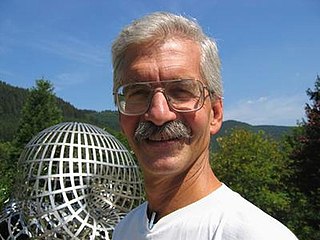Related Research Articles
In mathematics, the Weil conjectures were highly influential proposals by André Weil (1949). They led to a successful multi-decade program to prove them, in which many leading researchers developed the framework of modern algebraic geometry and number theory.
In mathematics, a modular form is a (complex) analytic function on the upper half-plane satisfying a certain kind of functional equation with respect to the group action of the modular group, and also satisfying a growth condition. The theory of modular forms therefore belongs to complex analysis but the main importance of the theory has traditionally been in its connections with number theory. Modular forms appear in other areas, such as algebraic topology, sphere packing, and string theory.

In mathematics, p-adic analysis is a branch of number theory that deals with the mathematical analysis of functions of p-adic numbers.

Pierre René, Viscount Deligne is a Belgian mathematician. He is best known for work on the Weil conjectures, leading to a complete proof in 1973. He is the winner of the 2013 Abel Prize, 2008 Wolf Prize, 1988 Crafoord Prize, and 1978 Fields Medal.
In mathematics, the Sato–Tate conjecture is a statistical statement about the family of elliptic curves Ep obtained from an elliptic curve E over the rational numbers by reduction modulo almost all prime numbers p. Mikio Sato and John Tate independently posed the conjecture around 1960.

In mathematics, an arithmetic group is a group obtained as the integer points of an algebraic group, for example They arise naturally in the study of arithmetic properties of quadratic forms and other classical topics in number theory. They also give rise to very interesting examples of Riemannian manifolds and hence are objects of interest in differential geometry and topology. Finally, these two topics join in the theory of automorphic forms which is fundamental in modern number theory.
In harmonic analysis and number theory, an automorphic form is a well-behaved function from a topological group G to the complex numbers which is invariant under the action of a discrete subgroup of the topological group. Automorphic forms are a generalization of the idea of periodic functions in Euclidean space to general topological groups.

Nicholas Michael Katz is an American mathematician, working in arithmetic geometry, particularly on p-adic methods, monodromy and moduli problems, and number theory. He is currently a professor of Mathematics at Princeton University and an editor of the journal Annals of Mathematics.

In mathematics, arithmetic geometry is roughly the application of techniques from algebraic geometry to problems in number theory. Arithmetic geometry is centered around Diophantine geometry, the study of rational points of algebraic varieties.
In category theory, a branch of mathematics, given a morphism f: X → Y and a morphism g: Z → Y, a lift or lifting of f to Z is a morphism h: X → Z such that f = g∘h. We say that f factors through h.
In mathematics, a p-adic zeta function, or more generally a p-adic L-function, is a function analogous to the Riemann zeta function, or more general L-functions, but whose domain and target are p-adic. For example, the domain could be the p-adic integersZp, a profinite p-group, or a p-adic family of Galois representations, and the image could be the p-adic numbersQp or its algebraic closure.

Robert Frederick Coleman was an American mathematician, and professor at the University of California, Berkeley.
In mathematics, the André–Oort conjecture is a problem in Diophantine geometry, a branch of number theory, that can be seen as a non-abelian analogue of the Manin–Mumford conjecture, which is now a theorem. The conjecture concerns itself with a characterization of the Zariski closure of sets of special points in Shimura varieties. A special case of the conjecture was stated by Yves André in 1989 and a more general statement was conjectured by Frans Oort in 1995. The modern version is a natural generalization of these two conjectures.
Mathematics is a broad subject that is commonly divided in many areas that may be defined by their objects of study, by the used methods, or by both. For example, analytic number theory is a subarea of number theory devoted to the use of methods of analysis for the study of natural numbers.
In mathematics, a p-adic modular form is a p-adic analog of a modular form, with coefficients that are p-adic numbers rather than complex numbers. Serre (1973) introduced p-adic modular forms as limits of ordinary modular forms, and Katz (1973) shortly afterwards gave a geometric and more general definition. Katz's p-adic modular forms include as special cases classical p-adic modular forms, which are more or less p-adic linear combinations of the usual "classical" modular forms, and overconvergent p-adic modular forms, which in turn include Hida's ordinary modular forms as special cases.
In mathematics, the q-expansion principle states that a modular form f has coefficients in a module M if its q-expansion at enough cusps resembles the q-expansion of a modular form g with coefficients in M. It was introduced by Katz.
In algebraic geometry, a level structure on a space X is an extra structure attached to X that shrinks or eliminates the automorphism group of X, by demanding automorphisms to preserve the level structure; attaching a level structure is often phrased as rigidifying the geometry of X.

Jennifer Shyamala Sayaka Balakrishnan is an American mathematician known for leading a team that solved the problem of the "cursed curve", a Diophantine equation that was known for being "famously difficult". More generally, Balakrishnan specializes in algorithmic number theory and arithmetic geometry. She is the Clare Boothe Luce Associate Professor at Boston University.

Sergei Alekseevich Evdokimov was a Russian mathematician who contributed to the theory of modular forms, computational complexity theory, algebraic combinatorics and p-adic analysis.
Adrian Ioviță is a Romanian-Canadian mathematician, specializing in arithmetic algebraic geometry and p-adic cohomology theories.
References
- Coleman, Robert F. (1996), "Classical and Overconvergent Modular Forms", Invent. Math., 124 (1–3): 215–241, doi:10.1007/s002220050051, MR 1369416
- Robert F. Coleman, Classical and overconvergent modular forms. Les Dix-huitièmes Journées Arithmétiques (Bordeaux, 1993). J. Théor. Nombres Bordeaux 7 (1995), no. 1, 333–365. Zbl 1073.11515
- Robert F. Coleman Classical and Overconvergent Modular Forms of Higher Level, J. Theor. Nombres Bordeaux 9 (1997), no. 2, 395–403.
- Katz, Nicholas M. p-adic properties of modular schemes and modular forms. Modular functions of one variable, III (Proc. Internat. Summer School, Univ. Antwerp, Antwerp, 1972), pp. 69–190. Lecture Notes in Mathematics, Vol. 350, Springer, Berlin, 1973.